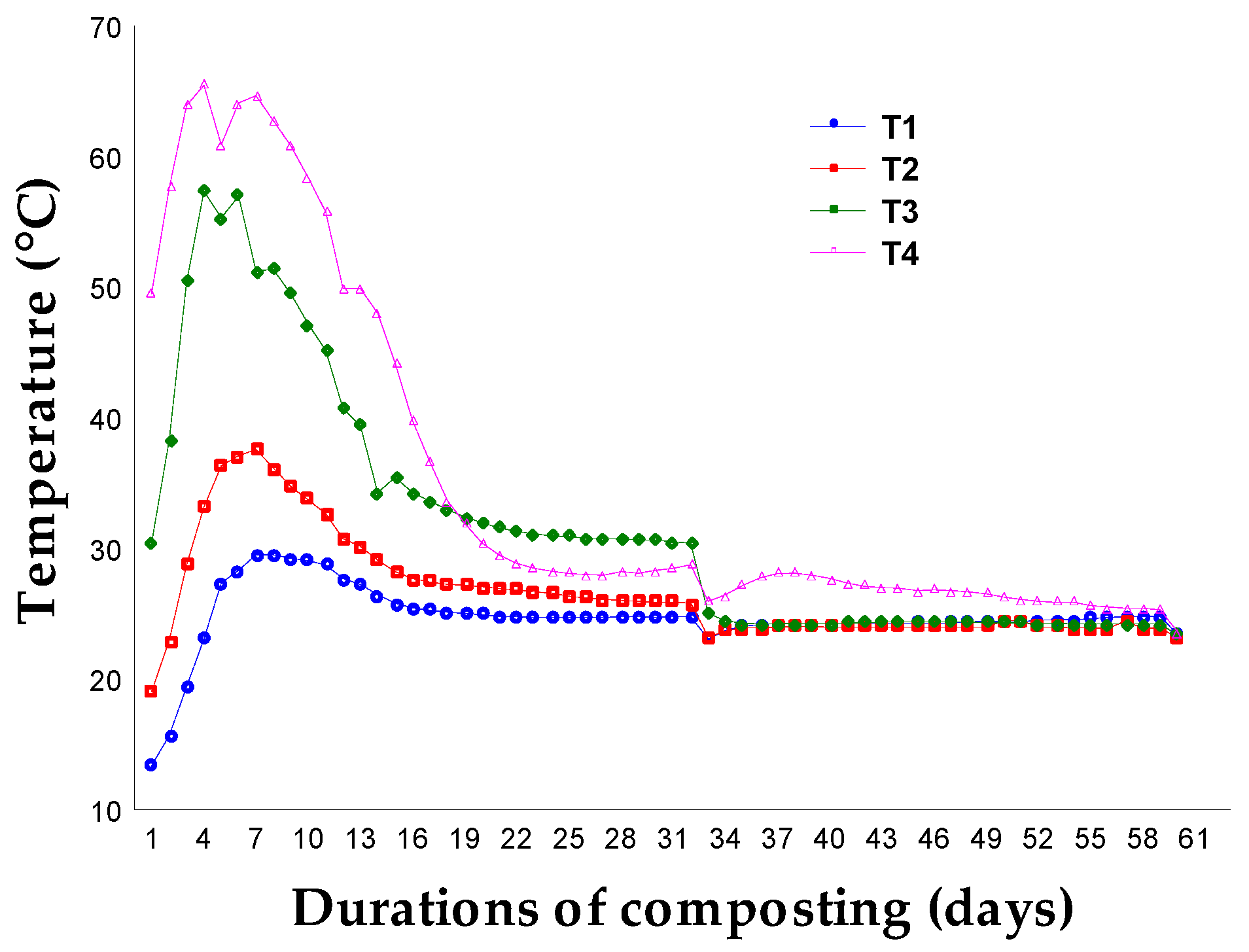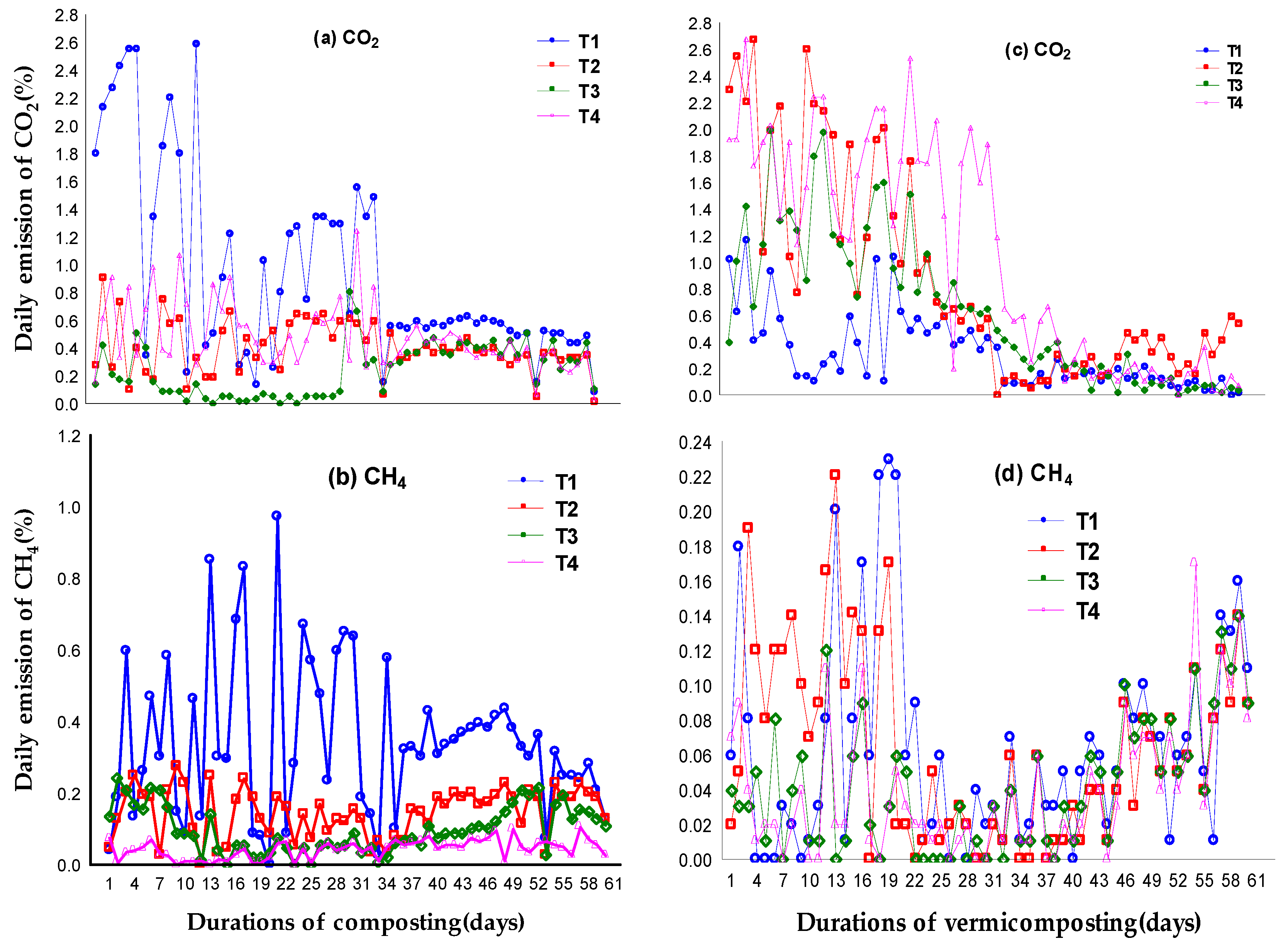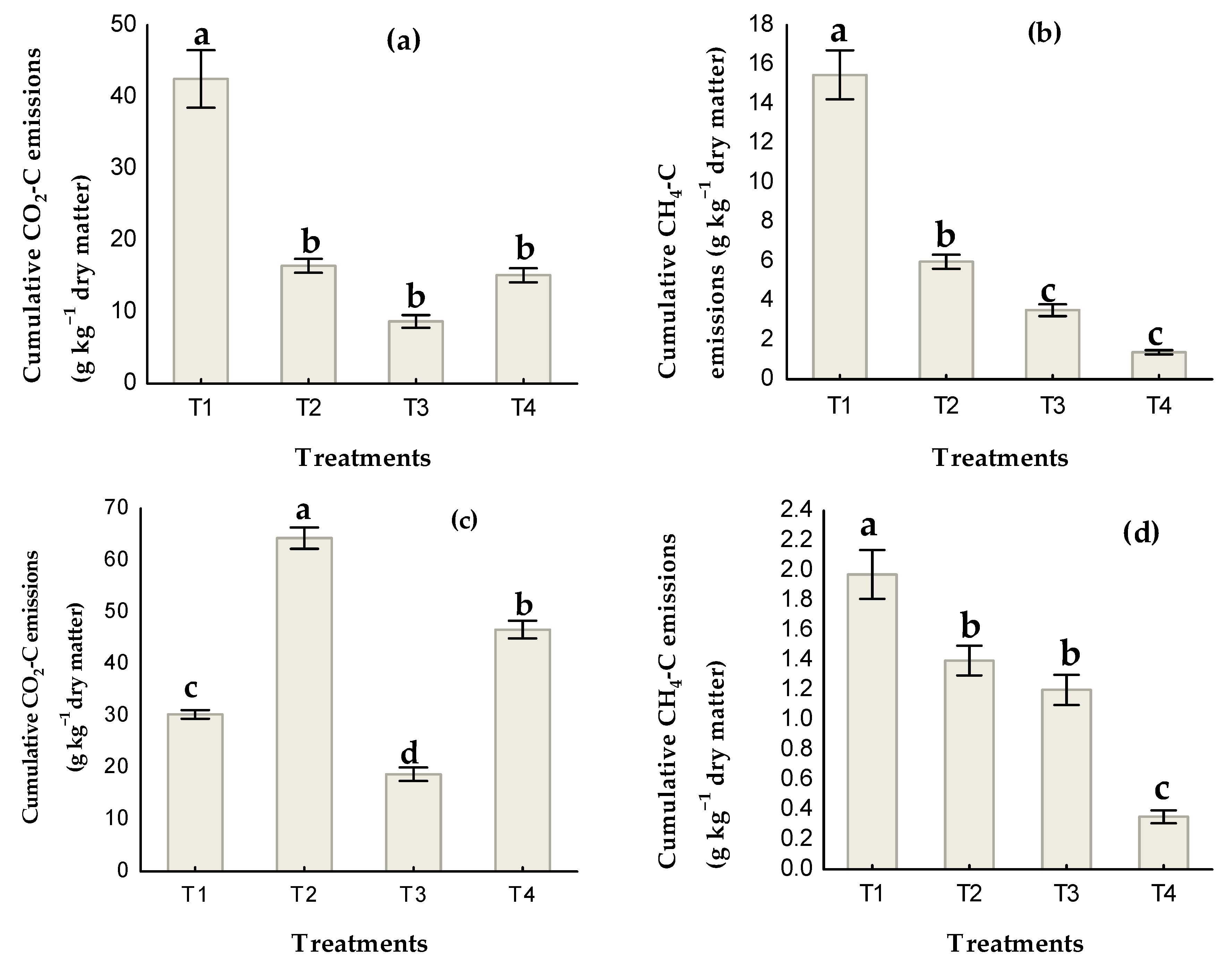Carbon Dioxide and Methane Emissions during the Composting and Vermicomposting of Sewage Sludge under the Effect of Different Proportions of Straw Pellets †
Abstract
:1. Introduction
2. Materials and Methods
2.1. Raw Materials
2.2. Experimental Design
2.3. Measurements of Carbon Dioxide (CO2) and Methane (CH4) during Composting and Vermicomposting
2.4. Analysis of Total Carbon (TOC), Total Nitrogen (TN), pH, and EC
2.5. Statistical Analyses
3. Results and Discussions
3.1. Temperature during Composting
3.2. pH and EC
3.3. Emissions of CO2 and CH4 during Composting and Vermicomposting
3.3.1. Carbon Dioxide (CO2)
3.3.2. Methane (CH4)
3.4. Total Organic Carbon (TOC), Total Nitrogen (TN) and the C:N Ratio
4. Conclusions
Institutional Review Board Statement
Informed Consent Statement
Data Availability Statement
Acknowledgments
Conflicts of Interest
References
- Lv, B.; Di, Z.; Cui, Y.; Yin, F. Effects of C/N ratio and earthworms on greenhouse gas emissions during vermicomposting of sewage sludge. Bioresour. Technol. 2018, 268, 408–414. [Google Scholar] [CrossRef]
- Sadef, Y.; Poulsen, T.G.; Habib, K.; Iqbal, T.; Nizami, A.S. Uncertainty in degradation rates for organic micro-pollutants during full-scale sewage sludge composting. Waste Manag. 2016, 56, 396–402. [Google Scholar] [CrossRef]
- He, C.; Chen, C.L.; Giannis, A.; Yang, Y.; Wang, J.Y. Hydrothermal gasification of sewage sludge and model compounds for renewable hydrogen production: A review. Renew. Sustain. Energy Rev. 2014, 39, 1127–1142. [Google Scholar] [CrossRef]
- NBSC (National Bureau of Statistics of China). China Statistical Yearbook; China Statistics Press: Beijing, China, 2016.
- Jain, M.S.; Jambhulkar, R.; Kalamdhad, A.S. Biochar amendment for batch composting of nitrogen rich organic waste: Effect on degradation kinetics, composting physics and nutritional properties. Bioresour. Technol. 2018, 253, 204–213. [Google Scholar] [CrossRef] [PubMed]
- Meng, L.Q.; Zhang, S.M.; Gong, H.N.; Zhang, X.C.; Wu, C.D.; Li, W.G. Improving sewage sludge composting by addition of spent mushroom substrate and sucrose. Bioresour. Technol. 2018, 253, 197–203. [Google Scholar] [CrossRef] [PubMed]
- IPCC. Climate Change. Mitigation of Climate Change; Cambridge University Press: Cambridge, UK, 2014. [Google Scholar]
- Sun, W.; Deng, L.; Wu, G.; Wu, L.; Han, P.; Miao, Y.; Yao, B. Atmospheric monitoring of methane in Beijing using a mobile observatory. Atmos 2019, 10, 554. [Google Scholar] [CrossRef] [Green Version]
- Wang, J.; Zhang, X.; Xiong, Z. Methane emissions from a rice agroecosystem in South China: Effects of water regime, straw incorporation and nitrogen fertilizer. Nutr. Cycl. Agroecosyst. 2012, 93, 103–112. [Google Scholar] [CrossRef]
- Wu, H.P.; Lai, C.; Zeng, G.M.; Liang, J.; Chen, J.; Xu, J.J.; Dai, J.; Li, X.D.; Liu, J.F.; Chen, M.; et al. The interactions of composting and biochar and their implications for soil amendment and pollution remediation: A review. Critic. Rev. Biotechnol. 2017, 37, 754–764. [Google Scholar] [CrossRef]
- Wang, J.; Hu, Z.; Xu, X.; Jiang, X.; Zheng, B.; Liu, X.; Pan, X.; Kardol, P. Emissions of ammonia and greenhouse gases during combined pre-composting and vermicomposting of duck manure. Waste Manag. 2014, 34, 1546–1552. [Google Scholar] [CrossRef] [PubMed]
- Sharma, K.; Garg, V. Comparative analysis of vermicompost quality produced from rice straw and paper waste employing earthworm Eisenia fetida (Sav.). Bioresour. Technol. 2018, 250, 708–715. [Google Scholar] [CrossRef] [PubMed]
- Balachandar, R.; Baskaran, L.; Yuvaraj, A.; Thangaraj, R.; Subbaiya, R.; Ravindran, B.; Chang, S.W.; Karmegam, N. Enriched pressmud vermicompost production with green manure plants using Eudrilus eugeniae. Bioresour. Technol. 2020, 299, 122578. [Google Scholar] [CrossRef] [PubMed]
- Suthar, S. Pilot-scale vermireactors for sewage sludge stabilization and metal remediation process: Comparison with small-scale vermireactors. Ecol. Eng. 2010, 36, 703–712. [Google Scholar] [CrossRef]
- He, X.; Zhang, Y.; Shen, M.; Zeng, G.; Zhou, M.; Li, M. Effect of vermicomposting on concentration and speciation of heavy metals in sewage sludge with additive materials. Bioresour. Technol. 2016, 218, 867–873. [Google Scholar] [CrossRef] [PubMed]
- Garg, P.; Gupta, A.; Satya, S. Vermicomposting of different types of waste using Eisenia foetida: A comparative study. Bioresour. Technol. 2006, 97, 391–395. [Google Scholar] [CrossRef] [PubMed]
- Tognetti, C.; Laos, F.; Mazzarino, M.J.; Hernandez, M.T. Composting vs. vermicomposting: A comparison of end product quality. Compost Sci. Util. 2005, 13, 6–13. [Google Scholar] [CrossRef]
- El-Haddad, M.E.; Zayed, M.S.; El-Sayed, G.A.M.; Hassanein, M.K.; El-Satar, A.M.A. Evaluation of compost, vermicompost and their teas produced from rice straw as affected by addition of different supplements. Ann. Agric. Sci. 2014, 59, 243–251. [Google Scholar] [CrossRef] [Green Version]
- Ramnarain, Y.I.; Ansari, A.A.; Ori, L. Vermicomposting of different organic materials using the epigeic earthworm Eisenia foetida. Int. J. Recycl. Org. Waste Agric. 2019, 8, 23–36. [Google Scholar] [CrossRef] [Green Version]
- Jadia, C.D.; Fulekar, M.H. Vermicomposting of vegetable wastes: A biophysicochemical process based on hydro-operating bioreactor. Afr. J. Biotechnol. 2008, 7, 3723–3730. [Google Scholar]
- Awasthi, M.K.; Wang, Q.; Huang, H.; Li, R.; Shen, F.; Lahori, A.H.; Wang, P.; Guo, D.; Guo, Z.; Jiang, S.; et al. Effect of biochar amendment on greenhouse gas emission and bio-availability of heavy metals during sewage sludge cocomposting. J. Clean. Prod. 2016, 135, 829–835. [Google Scholar] [CrossRef]
- Zhang, J.Y.; Sui, Q.W.; Li, K.; Chen, M.X.; Tong, J.; Qi, L.; Wei, Y.S. Influence of natural zeolite and nitrification inhibitor on organics degradation and nitrogen transformation during sludge composting. Environ. Sci. Pollut. Res. 2016, 23, 1324–1334. [Google Scholar] [CrossRef] [PubMed]
- Jiang, T.; Ma, X.G.; Tang, Q.; Yang, J.; Li, G.X.; Schuchardt, F. Combined use of nitrification inhibitor and struvite crystallization to reduce the NH3 and N2O emissions during composting. Bioresour. Technol. 2016, 217, 210–218. [Google Scholar] [CrossRef]
- Santos, C.; Fonseca, J.; Aires, A.; Coutinho, J.; Trindade, H. Effect of different rates of spent coffee grounds (SCG) on composting process, gaseous emissions and quality of end-product. Waste Manag. 2017, 59, 37–47. [Google Scholar] [CrossRef]
- Awasthi, M.K.; Wang, Q.; Awasthi, S.K.; Wang, M.J.; Chen, H.Y.; Ren, X.N.; Zhao, J.C.; Zhang, Z.Q. Influence of medical stone amendment on gaseous emissions, microbial biomass and abundance of ammonia oxidizing bacteria genes during biosolids composting. Bioresour. Technol. 2018, 247, 970–979. [Google Scholar] [CrossRef] [PubMed]
- Ma, S.; Fang, C.; Sun, X.; Han, L.; He, X.; Huang, G. Bacterial community succession during pig manure and wheat straw aerobic composting covered with a semi-permeable membrane under slight positive pressure. Bioresour. Technol. 2018, 259, 221–227. [Google Scholar] [CrossRef] [PubMed]
- Wang, Q.; Awasthi, M.K.; Ren, X.N.; Zhao, J.C.; Li, R.H.; Wang, Z.; Wang, M.J.; Chen, H.Y.; Zhang, Z.Q. Combining biochar, zeolite and wood vinegar for composting of pig manure: The effect on greenhouse gas emission and N conservation. Waste Manag. 2018, 74, 221–223. [Google Scholar] [CrossRef]
- Manios, T.; Maniadakis, K.; Boutzakis, P.; Naziridis, Y.; Lasaridi, K.; Markakis, G.; Stentiford, E.I. Methane and carbon dioxide emission in a two-phase olive oil mill sludge windrow pile during composting. Waste Manag. 2007, 27, 1092–1098. [Google Scholar] [CrossRef]
- Awasthi, M.K.; Wang, M.J.; Chen, H.Y.; Wang, Q.; Zhao, J.C.; Ren, X.N.; Li, D.S.; Awasthi, S.K.; Shen, F.; Li, R.H.; et al. Heterogeneity of biochar amendment to improve the carbon and nitrogen sequestration through reduce the greenhouse gases emissions during sewage sludge composting. Bioresour. Technol. 2017, 224, 428–438. [Google Scholar] [CrossRef]
- Zhang, J.; Sugir, M.E.; Li, Y.; Yuan, L.; Zhou, M.; Lv, P.; Yu, Z.; Wang, L.; Zhou, D. Effects of vermicomposting on the main chemical properties and bioavailability of Cd/Zn in pure sludge. Environ. Sci. Pollut. Res. 2019, 26, 20949–20960. [Google Scholar] [CrossRef]
- Srivastava, V.; Goel, G.; Thakur, V.K.; Singh, R.P.; Ferreira de Araujo, A.S.; Singh, P. Analysis and advanced characterization of municipal solid waste vermicompost maturity for a green environment. J. Environ. Manag. 2020, 255, 109914. [Google Scholar] [CrossRef] [PubMed]
- Biruntha, M.; Karmegam, N.; Archana, J.; Karunai Selvi, B.; John Paul, J.A.; Balamuralikrishnan, B.; Chang, S.W.; Ravindran, B. Vermiconversion of biowastes with low-to-high C/N ratio into value added vermicompost. Bioresour. Technol. 2020, 297, 122398. [Google Scholar] [CrossRef]
- Esmaeili, A.; Khoram, M.R.; Gholami, M.; Eslami, H. Pistachio waste management using combined composting-vermicomposting technique: Physico-chemical changes and worm growth analysis. J. Clean. Prod. 2020, 242, 118523. [Google Scholar] [CrossRef]



| Parameters | Sewage Sludge (SS) | Pelletized Wheat Straw (PWS) |
|---|---|---|
| pH-H2O | 6.99 ± 0.03 | 8.30 ± 0.52 |
| EC (mS/cm) | 0.617 ± 0.11 | 0.680 ± 0.07 |
| TOC (%) | 32.95 ± 0.26 | 42.6 ± 0.36 |
| TN (%) | 5.36 ± 0.03 | 0.8 ± 0.12 |
| C:N | 6.15 ± 0.04 | 53.2 ± 7.60 |
| Treatments | pH-H2O | EC (mS/cm) | TOC (%) | TN (%) | C:N |
|---|---|---|---|---|---|
| T1 | 6.99 ± 0.03 | 0.617 ± 0.11 | 32.9 ± 0.26 | 5.36 ± 0.03 | 6.14 ± 0.04 |
| T2 | 7.32 ± 0.11 | 0.633 ± 0.08 | 35.36 ± 0.23 | 1.98 ± 0.21 | 18.03 ± 1.92 |
| T3 | 7.64 ± 0.25 | 0.649 ± 0.06 | 37.77 ± 0.24 | 1.34 ± 0.07 | 28.17 ± 1.43 |
| T4 | 7.97 ± 0.38 | 0.664 ± 0.05 | 40.18 ± 0.29 | 1.05 ± 0.05 | 38.36 ± 2.03 |
| Processes | Treatments | pH-H2O | EC (mS/cm) | TOC (%) | TN (%) | C:N |
|---|---|---|---|---|---|---|
| C | T1 | 8.43 ± 0.12 | 1.90 ± 0.17 | 29.52 ± 0.73 | 4.55 ± 0.14 | 6.50 ± 0.04 |
| T2 | 8.32 ± 0.09 | 1.43 ± 0.09 | 32.43 ± 0.79 | 3.69 ± 0.03 | 8.84 ± 0.32 | |
| T3 | 8.35 ± 0.08 | 1.94 ± 0.14 | 34.45 ± 1.53 | 3.27 ± 0.05 | 10.57 ± 0.65 | |
| T4 | 8.01 ± 0.06 | 0.80 ± 0.06 | 37.95 ± 0.02 | 2.76 ± 0.15 | 13.88 ± 0.80 | |
| VC | T1 | 6.66 ± 1.16 | 0.644 ± 0.04 | 28.43 ± 0.32 | 4.22 ± 0.20 | 6.77 ± 0.26 |
| T2 | 6.47 ± 1.5 | 1.186 ± 0.22 | 31.96 ± 0.89 | 3.58 ± 0.04 | 8.94 ± 0.35 | |
| T3 | 6.50 ± 0.14 | 0.802 ± 0.39 | 34.38 ± 1.13 | 2.95 ± 0.15 | 11.72 ± 0.93 | |
| T4 | 6.65 ± 0.31 | 1.21 ± 0.12 | 35.32 ± 0.37 | 3.08 ± 0.06 | 12.15 ± 0.32 |
Publisher’s Note: MDPI stays neutral with regard to jurisdictional claims in published maps and institutional affiliations. |
© 2021 by the authors. Licensee MDPI, Basel, Switzerland. This article is an open access article distributed under the terms and conditions of the Creative Commons Attribution (CC BY) license (https://creativecommons.org/licenses/by/4.0/).
Share and Cite
Dume, B.; Hanč, A.; Švehla, P.; Chane, A.; Nigussie, A. Carbon Dioxide and Methane Emissions during the Composting and Vermicomposting of Sewage Sludge under the Effect of Different Proportions of Straw Pellets. Environ. Sci. Proc. 2021, 8, 7. https://doi.org/10.3390/ecas2021-10337
Dume B, Hanč A, Švehla P, Chane A, Nigussie A. Carbon Dioxide and Methane Emissions during the Composting and Vermicomposting of Sewage Sludge under the Effect of Different Proportions of Straw Pellets. Environmental Sciences Proceedings. 2021; 8(1):7. https://doi.org/10.3390/ecas2021-10337
Chicago/Turabian StyleDume, Bayu, Aleš Hanč, Pavel Švehla, Abraham Chane, and Abebe Nigussie. 2021. "Carbon Dioxide and Methane Emissions during the Composting and Vermicomposting of Sewage Sludge under the Effect of Different Proportions of Straw Pellets" Environmental Sciences Proceedings 8, no. 1: 7. https://doi.org/10.3390/ecas2021-10337
APA StyleDume, B., Hanč, A., Švehla, P., Chane, A., & Nigussie, A. (2021). Carbon Dioxide and Methane Emissions during the Composting and Vermicomposting of Sewage Sludge under the Effect of Different Proportions of Straw Pellets. Environmental Sciences Proceedings, 8(1), 7. https://doi.org/10.3390/ecas2021-10337







